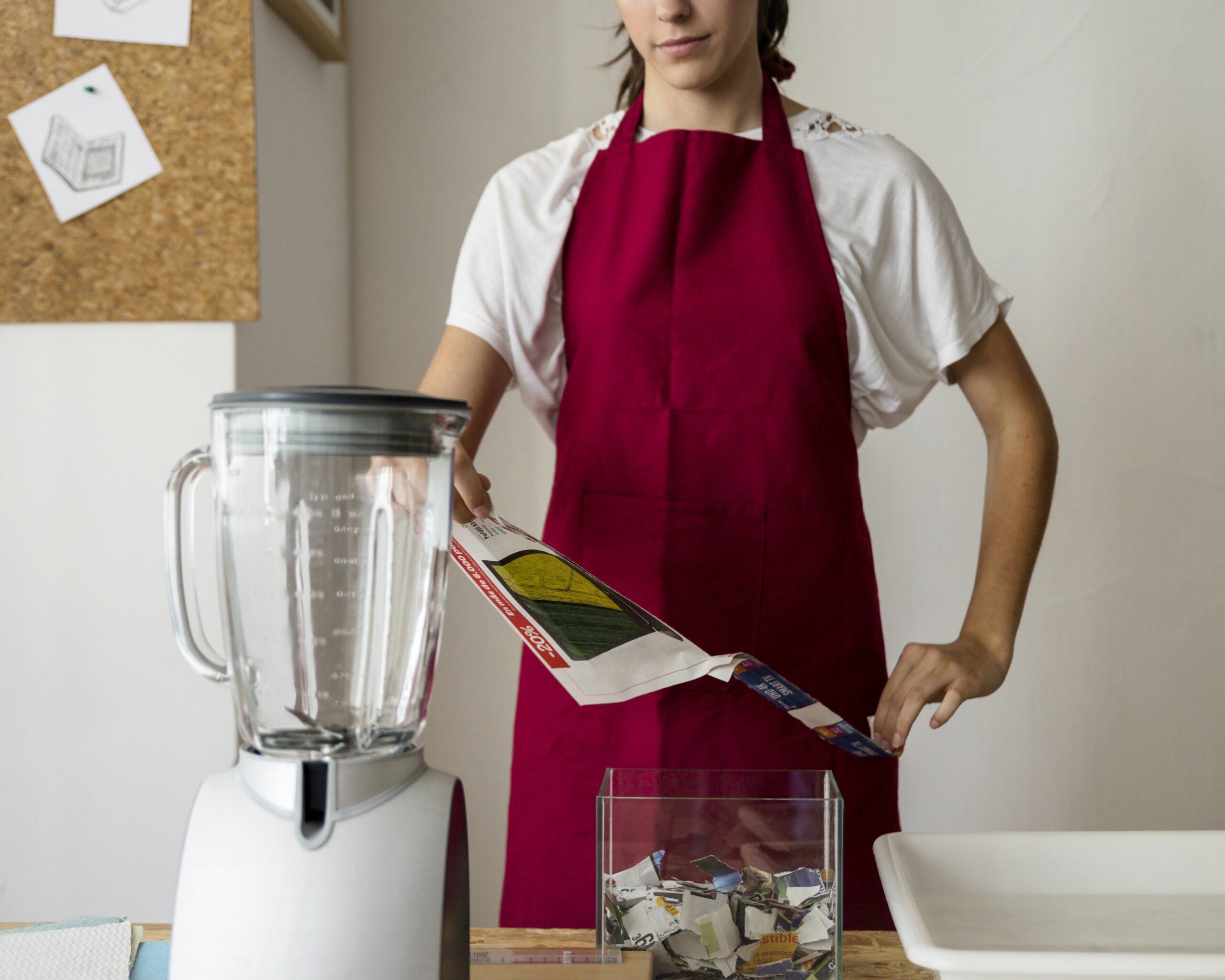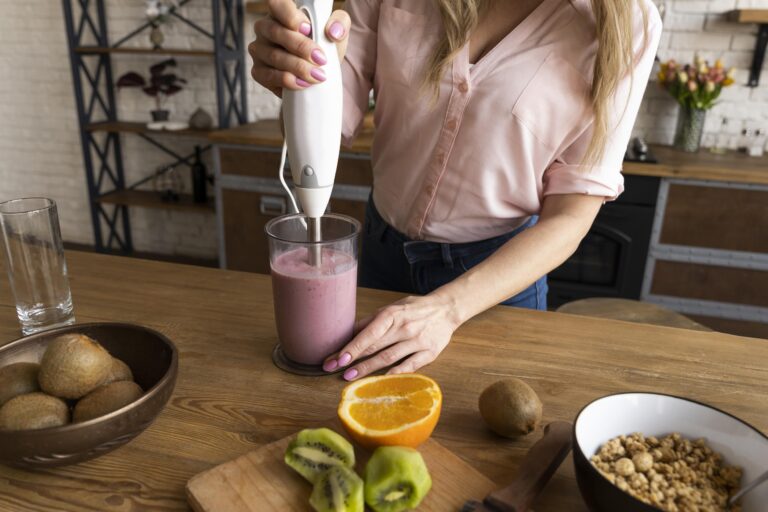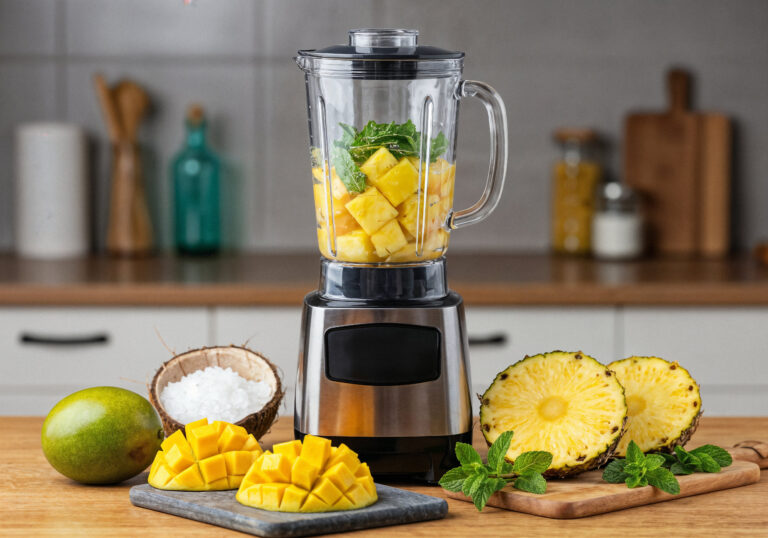Top 10 Best Food Blenders of 2025
The global blender market, now valued at over $20 billion, reflects a surge in demand for appliances that seamlessly blend nutrition and convenience, catering to a wide range of tasks from crafting velvety smoothies to preparing hearty soups and rich nut butters.
In this dynamic landscape, selecting the right blender can elevate your kitchen experience, transforming raw ingredients into culinary masterpieces with ease.
Drawing from the latest 2025 reviews and performance data, this comprehensive guide unveils the 10 Best Food Blenders of 2025, offering detailed insights into their capabilities, ideal uses, and critical factors to consider, empowering you to make an informed choice tailored to your lifestyle and culinary aspirations.
Top 10 Best Food Blenders of 2025
This section provides an in-depth exploration of the top 10 blenders, renowned for their exceptional performance across diverse food preparation tasks. Each review includes an overview, performance details, best use cases, pros and cons, pricing, and a concise table summarizing key specifications.
1. Vitamix 5200

- Overview: Widely acclaimed as the gold standard in blender technology, the Vitamix 5200 boasts a powerful 2-horsepower (1490-watt) motor paired with a 64 oz tall, tapered jar, earning its reputation among culinary enthusiasts since its introduction.
- Performance: This blender masterfully creates smooth blends, such as smoothies with kale and frozen berries or creamy nut butters, in under 30 seconds. Its distinctive vortex action ensures uniform consistency, while its ability to heat cold ingredients to a steaming 180°F (82°C) in about 6 minutes makes it perfect for hot soups. The variable speed control (1–10) and pulse feature provide precise customization.
- Best For: Dedicated home cooks or professionals seeking versatility for large batches, including smoothies, purees, and frozen desserts.
- Pros: Exceptional durability with aircraft-grade stainless-steel blades, manual speed adjustments, and a comprehensive 7-year warranty covering parts, labor, and shipping.
- Cons: Its towering height (20.5 inches) may not fit under standard kitchen cabinets; the premium price of $399–$449 might be a barrier for some.
- Price: $399–$449.
Spec Detail Wattage 1490W (2 HP) Capacity 64 oz Blend Time <30s Warranty 7 yrs
2. KitchenAid K400

- Overview: Celebrated for its sophisticated design and robust 1200-watt motor, the KitchenAid K400 features a 56 oz BPA-free jar and advanced controls, appealing to those who value both style and functionality.
- Performance: It transforms ice into a snow-like texture and blends green smoothies with spinach and banana in 30–40 seconds. Equipped with five speed settings and three preset programs (ice crush, smoothie, icy drinks), it tackles diverse tasks efficiently, though thick blends may benefit from the included tamper.
- Best For: Individuals who prioritize aesthetic appeal alongside effective ice-crushing and smoothie-making capabilities.
- Pros: Includes a self-clean cycle (30 seconds with warm water and soap), offers multiple color options (e.g., matte black, empire red), and is supported by a 5-year warranty.
- Cons: The small start button can be temperamental, occasionally requiring multiple presses; priced at $249–$299.
- Price: $249–$299.
Spec Detail Wattage 1200W Capacity 56 oz Blend Time 30–40s Warranty 5 yrs
3. NutriBullet Pro 900

- Overview: A sleek 900-watt personal blender, the NutriBullet Pro 900 comes with a 32 oz cup, designed for individuals seeking convenient, single-serve smoothies.
- Performance: It blends smoothies with mixed berries, spinach, and almond milk into a smooth consistency in 10–20 seconds. Its high-torque extractor blade adeptly handles fibrous ingredients, though thicker mixes may require manual stirring or added liquid for optimal results.
- Best For: Budget-conscious individuals or small households desiring an affordable, portable smoothie solution.
- Pros: Compact dimensions (5.2 x 6.9 x 15.6 inches), dishwasher-safe components, and a budget-friendly price of $79–$99.
- Cons: Lacks variable speed control, limiting flexibility; struggles with large ice cubes unless pre-crushed.
- Price: $79–$99.
Spec Detail Wattage 900W Capacity 32 oz Blend Time 10–20s Warranty 1 yr (3 yrs opt.)
4. Ninja Professional Blender

- Overview: Featuring a 1000-watt motor and a spacious 72 oz pitcher, the Ninja Professional Blender delivers a strong balance of power and affordability.
- Performance: It processes smoothies with frozen fruit and ice in 40–50 seconds, utilizing its stacked six-blade assembly to generate a robust blending vortex. It performs well with purees and salsas, though cleaning the blade area poses a challenge.
- Best For: Home cooks seeking a versatile blender with an excellent power-to-price ratio.
- Pros: Generous capacity for family servings, durable plastic build, and a competitive price of $99–$129.
- Cons: Blade assembly is difficult to clean thoroughly; noise levels can reach 85–90 dB.
- Price: $99–$129.
Spec Detail Wattage 1000W Capacity 72 oz Blend Time 40–50s Warranty 1 yr
5. Hamilton Beach Power Elite Multi-Function Blender

- Overview: A cost-effective 700-watt blender with a 48 oz glass jar, this model is tailored for basic food preparation needs.
- Performance: It blends simple smoothies with bananas and milk in 30–40 seconds, but its lower power limits effectiveness with fibrous greens or large ice cubes, often necessitating multiple cycles.
- Best For: Casual users or those new to blending on a tight budget.
- Pros: Affordable at $39–$59, glass jar resists staining, and includes 12 blending functions.
- Cons: Limited power for tougher ingredients; basic feature set.
- Price: $39–$59.
Spec Detail Wattage 700W Capacity 48 oz Blend Time 30–40s Warranty 3 yrs
6. Breville Fresh & Furious

- Overview: This 1100-watt blender features a 50 oz BPA-free jar, a digital display, and five one-touch programs, attracting users who value quiet operation and modern design.
- Performance: It produces smooth frozen drinks and emulsifies mayonnaise in approximately 40 seconds. Its quiet operation (70–75 dB) and auto-clean function enhance usability, though the plastic base may show wear over time.
- Best For: Small kitchens or users seeking a quieter, stylish blender.
- Pros: Offers preset programs (green smoothie, frozen dessert), self-clean cycle, and a price of $199.
- Cons: Plastic components are less durable than metal; occasional blade wobble may occur.
- Price: $199.
Spec Detail Wattage 1100W Capacity 50 oz Blend Time 40s Warranty 1 yr
7. NutriBullet Ultra Personal Blender

- Overview: An enhanced 1200-watt personal blender with a 32 oz Tritan Renew cup (50% recycled content), equipped with titanium-coated blades for superior performance.
- Performance: It blends thick smoothies with avocado and nuts in 20–30 seconds, providing a quieter operation (lower frequency sound) compared to earlier models, though still around 90 dB.
- Best For: Power users looking for a portable, eco-friendly blending option.
- Pros: Utilizes sustainable materials, features durable blades, offers a 1–4 year warranty option, and is priced at $129–$150.
- Cons: Heavier at 10.14 lbs; suction cup feet may weaken with prolonged use.
- Price: $129–$150.
Spec Detail Wattage 1200W Capacity 32 oz Blend Time 20–30s Warranty 1–4 yrs (opt.)
8. Ninja Foodi Power Blender Ultimate System

- Overview: A versatile 1400-watt hybrid featuring a 72 oz pitcher and additional food processing attachments, designed for multi-tasking culinary enthusiasts.
- Performance: It blends smoothies in 30–40 seconds and efficiently processes dough or chops vegetables, thanks to its adaptable blade system.
- Best For: Users desiring a combination blender and food processor for diverse kitchen tasks.
- Pros: Includes multiple attachments (e.g., dough blade), boasts a sturdy build, and is priced at $199–$229.
- Cons: Requires significant storage space; assembly can be complex.
- Price: $199–$229.
Spec Detail Wattage 1400W Capacity 72 oz Blend Time 30–40s Warranty 1 yr
9. Blendtec Total Blender Classic

- Overview: A high-performance 1560-watt blender with a 75 oz jar and blunt, patented blades, celebrated for its long-lasting durability.
- Performance: It crushes ice and blends tough ingredients like almonds into butter in 20–30 seconds without a tamper, utilizing its 10-speed touch slider and pre-programmed cycles.
- Best For: Individuals prioritizing durability and heavy-duty blending capabilities.
- Pros: Backed by an 8-year warranty, offers pre-programmed cycles (e.g., smoothie, ice cream), and is priced at $379.
- Cons: Touchscreen interface may be less intuitive for some users; bulky dimensions (15.5 x 7 x 7.5 inches).
- Price: $379.
Spec Detail Wattage 1560W Capacity 75 oz Blend Time 20–30s Warranty 8 yrs
10. Vitamix Ascent Series

- Overview: A premium lineup (e.g., A3500 model) featuring a 2.2-horsepower motor, smart technology, and a 64 oz Low-Profile container, designed for the tech-savvy cook.
- Performance: It blends smoothies and purees in 20–30 seconds, with self-detect containers that automatically adjust settings via wireless connectivity, enhancing precision.
- Best For: Tech-savvy users or those seeking high-end versatility for a wide range of blending tasks.
- Pros: Features a touchscreen interface, 10 variable speeds, a 10-year warranty, and is priced at $549–$649.
- Cons: High cost; requires additional space for accessories and compatible containers.
- Price: $549–$649.
Spec Detail Wattage 2200W (2.2 HP) Capacity 64 oz Blend Time 20–30s Warranty 10 yrs
Best Blender for 2025: Vitamix 5200

The Vitamix 5200 stands out as the best overall blender for 2025, a title it has consistently earned through rigorous testing and widespread acclaim.
Powered by a robust 2-horsepower (1490-watt) motor, this full-size blender features a 64 oz tall, tapered jar that accommodates large batches with ease.
Its versatility shines across a spectrum of tasks, from creating velvety smoothies with kale and frozen berries in under 30 seconds to heating cold ingredients to a steaming 180°F (82°C) for hot soups in about 6 minutes.
The variable speed control (1–10) and pulse function allow for precise adjustments, ensuring perfect consistency every time.
What sets the Vitamix 5200 apart is its durability, backed by aircraft-grade stainless-steel blades and a comprehensive 7-year warranty covering parts, labor, and shipping.
This blender excels at crushing ice, emulsifying sauces, and even grinding nuts into butter, making it a powerhouse for diverse culinary needs.
However, its 20.5-inch height may pose a challenge for kitchens with low cabinets, and its premium price of $399–$449 might be a consideration for budget-conscious buyers. The lack of preset programs is offset by its intuitive manual controls, which experts and home cooks alike praise for delivering superior results without complexity.
The Vitamix 5200’s reputation is reinforced by its ability to produce silkier blends than many competitors, a testament to its powerful motor and well-designed jar shape.
For those seeking a long-term investment in a blender that handles everything from morning smoothies to gourmet recipes, the Vitamix 5200 is the undisputed champion of 2025.
Best Blender for Protein Shakes 2025: Ninja Foodi Power Nutri DUO
For fitness enthusiasts and those prioritizing protein shakes, the Ninja Foodi Power Nutri DUO emerges as the best blender for 2025. This personal blender, equipped with a 1100-watt motor, comes with a pair of 24 oz jars featuring resealable spout lids, allowing you to blend and go without transferring to another container. Its standout feature is the ‘Smoothie Bowl Maker’ jar, which excels at handling ice-heavy drinks and thick blends like homemade nut butter, perfect for enhancing protein shakes with peanut or almond butter.
The Ninja Foodi Power Nutri DUO’s SmartTORQUE technology ensures the blades maintain steady power through tough ingredients like frozen fruit, kale, and protein powder, delivering a virtually smooth mix in 30–40 seconds. The rotating arms inside the jar stir ingredients without requiring manual intervention, a significant advantage over many personal blenders that struggle with thick recipes. Its ease of cleaning—both by hand and dishwasher-safe components—adds to its appeal for busy lifestyles.
While it can be noisy, the inclusion of blending programs allows users to step away during operation, mitigating this drawback. Priced competitively at $99–$129, it offers excellent value for its versatility and performance. Compared to alternatives like the NutriBullet Pro 900, which blends well but lacks the DUO’s advanced stirring mechanism, the Ninja Foodi Power Nutri DUO is ideal for those who need a reliable, portable solution for daily protein shakes, whether at home or on the go.
Best Stick Blender 2025: Breville Control Grip Immersion Blender
When it comes to stick blenders, the Breville Control Grip Immersion Blender takes the top spot for 2025, offering a blend of power, safety, and convenience. This cordless model features a 280-watt motor with a variable speed trigger and 15 speed settings, providing precise control for tasks ranging from pureeing soups directly in the pot to whipping creamy sauces. Its ergonomic design includes a bell-shaped blade guard that minimizes splashing and protects non-stick cookware, a critical feature for safe handling.
The Breville Control Grip comes with a robust set of attachments, including a 25 oz chopping bowl, a whisk, and a 42 oz blending jug, enhancing its versatility beyond basic blending. Its lightweight construction and charge stand make it easy to store and use over a hot hob without cable concerns. Testing reveals it blends fibrous ingredients like kale and beets into smooth consistencies in 30–40 seconds, and its AutoClean function clears residue in about 30 seconds, simplifying maintenance.
Priced at around $199, it’s a premium investment, but its quiet operation (70–75 dB) and durable build justify the cost. Compared to budget stick blenders with limited speed options, the Breville’s advanced controls and attachments make it the best choice for home cooks who value efficiency and multifunctionality. Its patented quiet technology, a hallmark of Breville’s innovation, ensures it outperforms noisier competitors, making it ideal for blending hot liquids or delicate recipes without disrupting the kitchen environment.
Comparative Analysis and Considerations
Choosing the best blender depends on your specific needs, kitchen space, and budget. The Vitamix 5200 is the ultimate all-rounder, ideal for those who cook for families or experiment with complex recipes. Its 1490-watt motor and large capacity make it less suited for single servings or small spaces, but its longevity and warranty offer peace of mind. For protein shake aficionados, the Ninja Foodi Power Nutri DUO provides a compact, powerful alternative with portability at its core, perfect for gym-goers or individuals with limited counter space. Its 1100-watt motor handles thick blends effectively, though it may not match the Vitamix’s finesse with hot soups or nut butters.
The Breville Control Grip Immersion Blender, meanwhile, caters to those who prefer flexibility without committing to a countertop model. Its 280-watt motor is less powerful than its jug counterparts, but its design excels for small batches, hot liquids, and on-the-go blending. Noise levels, ease of cleaning, and accessory compatibility are additional factors—Vitamix and Breville offer self-clean options, while Ninja’s dishwasher-safe parts simplify post-blend cleanup.
Practical Tips for Optimal Use
To maximize performance across these blenders, start with 8–12 oz of liquid (e.g., water or milk) as a base, followed by softer ingredients like bananas, then add frozen fruits or ice. Use short pulses (2–3 seconds) for thick mixes to avoid motor strain, especially with lower-wattage models like the Breville. Clean immediately after use—self-clean cycles with warm water and soap (30–60 seconds) work for Vitamix and Breville, while Ninja parts benefit from hand-washing blade bases with a soft brush.
As of July 31, 2025, the Vitamix 5200 ($399–$449) reigns as the best blender for 2025, offering unmatched versatility and durability for a wide range of culinary tasks. The Ninja Foodi Power Nutri DUO ($99–$129) is the top choice for protein shakes, blending efficiency and portability for fitness-focused users. The Breville Control Grip Immersion Blender ($199) leads the stick blender category, delivering quiet, safe, and versatile performance for smaller or hot-liquid blending needs. These selections reflect the latest trends and user preferences, ensuring you can find the perfect blender to suit your 2025 kitchen adventures, whether you’re fueling workouts or crafting gourmet dishes.
Factors to Consider When Choosing a Blender
Selecting the right blender involves evaluating several key factors to align with your specific needs and preferences.
- Budget: Blenders span a wide price range, from budget options like the Hamilton Beach Power Elite ($39–$59) to luxury models like the Vitamix Ascent Series ($549–$649). Establish your budget to balance cost with long-term durability and advanced features.
- Intended Use: Identify your primary tasks. For smoothies, 900–1200 watts (e.g., NutriBullet Pro 900, KitchenAid K400) are sufficient. For soups, nut butters, or dough, 1400+ watts (e.g., Vitamix 5200, Blendtec) are recommended. Multi-taskers may prefer the Ninja Foodi’s food processing capabilities.
- Size and Capacity: Evaluate your kitchen space and serving requirements. Personal blenders (13.5–32 oz, e.g., NutriBullet Ultra) suit individuals, while larger jars (48–75 oz, e.g., Ninja Professional, Blendtec) are better for family portions. Consider height constraints, such as the Vitamix 5200’s 20.5 inches, which may not fit under low cabinets.
- Features: Advanced models provide preset programs (e.g., Breville Fresh & Furious’s green smoothie setting), variable speed controls (Vitamix 5200), or smart technology (Vitamix Ascent). Basic models like Hamilton Beach rely on manual operation, offering simplicity over customization.
- Ease of Use and Cleaning: Opt for intuitive controls and efficient cleaning options. Self-clean cycles (KitchenAid K400, Vitamix Ascent) involve blending warm water and soap for 30–60 seconds. Most components (cups, lids) are dishwasher-safe, but blade bases often require hand-washing with a soft brush to prevent damage, particularly in models like Ninja Professional with intricate blade assemblies.
Tips for Optimal Blender Performance
- Ingredient Order: Begin with 8–12 oz of liquid (e.g., water, milk) to establish a base, followed by soft items (e.g., banana), and then frozen fruits or ice to optimize blending efficiency and safeguard the motor.
- Pulse Technique: Employ short pulses (2–3 seconds) for thick mixes or ice to avoid overloading, especially with lower-wattage blenders like Hamilton Beach.
- Immediate Cleaning: Rinse with warm, soapy water or activate a self-clean cycle immediately after use to prevent residue buildup, which is especially important for sticky ingredients like nut butters or avocado.
Frequently Asked Questions (FAQs)
1. What makes a blender suitable for a variety of food tasks?
A versatile blender, such as the Vitamix 5200 or Blendtec Total Blender Classic, is defined by a high wattage motor (1400–2200 watts) capable of handling smoothies, soups, and nut butters with ease.
Multiple speed settings, preset programs, and durable blades (e.g., stainless steel) ensure consistent results across diverse tasks. Larger capacities (64–75 oz) are ideal for family use, while self-cleaning features simplify maintenance, enhancing overall usability.
2. Can these blenders handle ice and frozen ingredients?
Yes, most models can process ice and frozen ingredients, though effectiveness varies. The KitchenAid K400, Ninja Professional, and Vitamix Ascent Series, with 1000–2200 watts and robust blades, excel at ice-crushing (30–40 seconds).
Lower-wattage options like the Hamilton Beach (700 watts) may require pre-crushed ice or additional liquid to prevent motor strain, often extending blending time.
3. How do I clean my blender effectively?
Clean your blender immediately after use to avoid residue hardening. For self-cleaning models (e.g., KitchenAid K400, Vitamix Ascent), fill the jar with warm water and a drop of dish soap, then blend for 30–60 seconds.
Most parts (cups, lids) are dishwasher-safe, but hand-wash blade bases with a soft brush to avoid damage, particularly in models like the Ninja Professional with complex blade designs.
4. Is a high-wattage blender necessary for all tasks?
Not necessarily. For basic smoothies, 700–900 watts (e.g., Hamilton Beach, NutriBullet Pro 900) are adequate, delivering results in 30–40 seconds.
For more demanding tasks like nut butters or frozen drinks, 1200–2200 watts (e.g., Vitamix 5200, Blendtec) provide superior performance, reducing blending time and minimizing motor wear, making them ideal for frequent, complex use.
5. Which blender is best for a small kitchen or travel?
For small kitchens, the NutriBullet Pro 900 ($79–$99) is an excellent choice, offering a 32 oz cup and compact dimensions (5.2 x 6.9 x 15.6 inches) that fit easily on countertops. For travel, the NutriBullet Ultra ($129–$150) provides a 32 oz portable cup with a to-go lid, though it’s heavier at 10.14 lbs. Both blend smoothies in 10–30 seconds, with the Ultra’s 1200-watt motor handling tougher ingredients more effectively.
Conclusion
As of July 31, 2025, the 10 Best Food Blenders of 2025 address a broad spectrum of culinary needs, ranging from budget-friendly essentials to premium, high-performance options.
The Vitamix 5200 ($399–$449) stands out as the premier choice, offering unparalleled versatility with its 1490-watt motor, 7-year warranty, and capability to handle everything from smoothies to hot soups, making it a perfect fit for dedicated home chefs.
For those who value style and power, the KitchenAid K400 ($249–$299) delivers impressive ice-crushing performance and a self-clean feature, ideal for modern kitchens. Budget-conscious users will find the Hamilton Beach Power Elite ($39–$59) a reliable option for basic tasks.
These blenders range from 700 to 2200 watts, with capacities spanning 32 oz to 75 oz, providing flexibility for individual servings or family-sized batches.
Warranties vary from 1 year (NutriBullet Pro 900, Ninja Professional) to 10 years (Vitamix Ascent), reflecting differing levels of durability for frequent use.
Consider your primary use case—smoothies for $79–$150 (NutriBullet models), or multi-tasking for $199–$649 (Ninja Foodi, Vitamix Ascent)—alongside kitchen space and cleaning preferences.
By applying the provided tips and FAQs, you can maximize your blender’s potential, ensuring consistent, delicious results that enhance your 2025 culinary journey.







